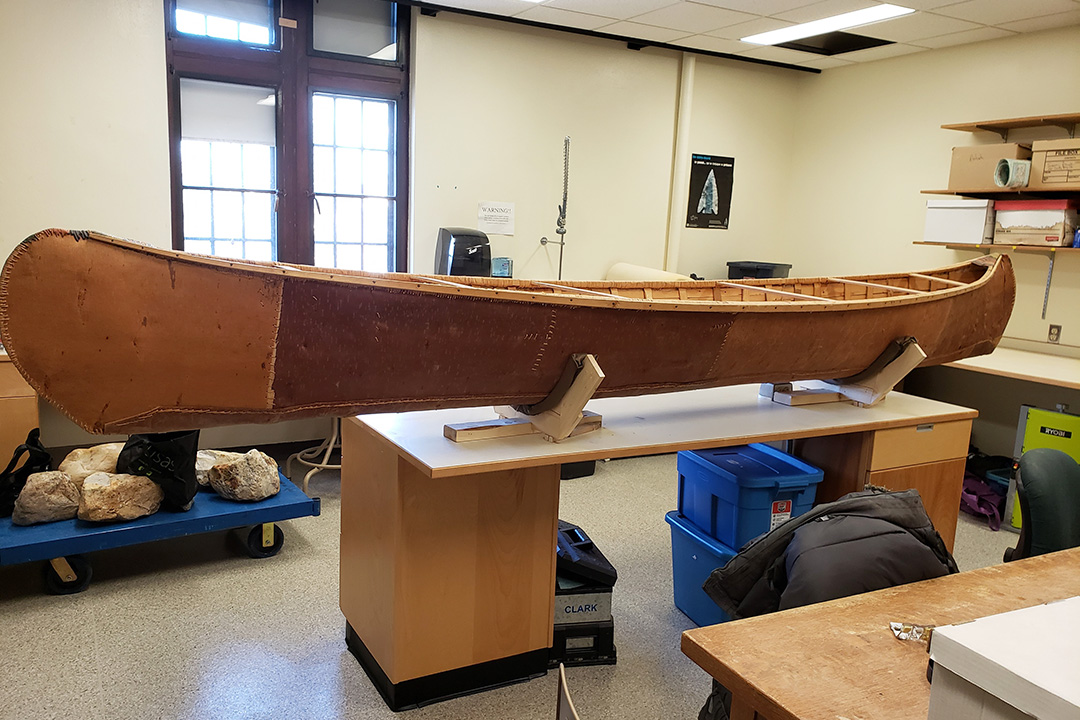
‘It’s back home’: USask faculty members assist in repatriation of decades-old birch bark canoe
Dr. Rose Roberts (PhD) remembers being a young child in the 1970s and watching as her grandparents, Isaiah and Annie Roberts, built a traditional birch bark canoe on the banks of Otter Lake, Sask., about 80 kilometres north of La Ronge.
By SHANNON BOKLASCHUK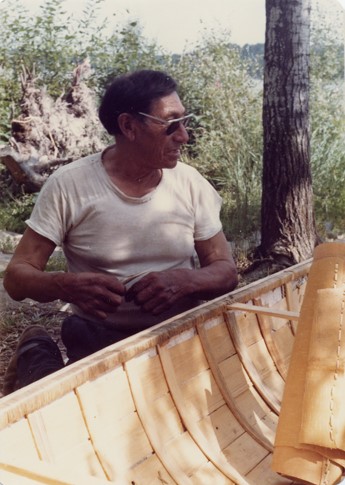
Roberts’ grandparents—fluent Cree speakers and members of the Lac La Ronge Indian Band—detailed their canoe-making process for a film titled My Last Canoe, which was produced in both Cree and English. They showed, step by step, how to utilize materials found on the land to create a fully functional and long-lasting vehicle for water transportation—complete with Annie’s trademark multi-coloured dyed sinew at the front and back of the canoe.
“I remember that summer, because I think for 13 or 14 summers we would go pitch a tent on the banks of Otter Lake and we would stay there for the summer while my dad guided for Thompson’s camps,” said Roberts, a Woodland Cree scholar at the University of Saskatchewan (USask) who grew up in Stanley Mission, Sask. “So a lot of our summers were spent there, and I remember walking with my grandmother into the bush to go find the roots that are used to sew up the birch bark.”
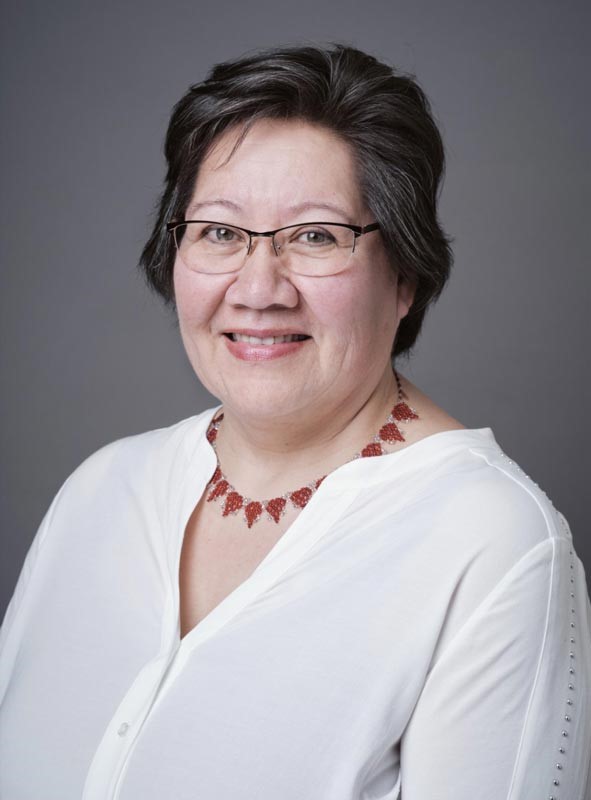
After the film was made, Roberts didn’t see the canoe again for decades. But earlier this year, following a twist of fate, Roberts’ family learned the canoe was still in existence and was being housed in a most unexpected place: the basement of the Archaeology Building on the USask campus.
“I’ve either been working or going to school at (USask) for the last 20 years, and I had no idea that my grandfather’s canoe was in the basement of the Archaeology Building all this time,” said Roberts (BSN’96, MSc’01, PhD’06), a three-time USask alumna who currently works as an educational development specialist with the Indigenous Voices team at the Gwenna Moss Centre for Teaching and Learning.
So how did the canoe come to be stored in the basement of the building? Who brought it to the USask campus all those years ago, and why?
The answers to those questions remain unclear, but two things were known for certain: the canoe in the basement of the Archaeology Building was built by Isaiah and Annie Roberts, and it needed to go home.
Although mysteries still surround the story of the canoe, it seems Roberts’ family and community members from the Lac La Ronge Indian Band were looking for the canoe at the same time as faculty members from the Department of Archaeology and Anthropology, located in USask’s College of Arts and Science, were looking to return it.

As part of the repatriation efforts, anthropology professor Dr. Jim Waldram (PhD) sent an email to faculty members at USask inquiring about the canoe and its history—and that email somehow made its way to Roberts. She was astounded to learn that the canoe referenced in Waldram’s email was, in fact, made by her grandparents, and so she promptly went to the Archaeology Building in February 2020 to view it in person.
“Just seeing it for the first time just brought back all of those memories of my childhood,” she said.
Seeing the canoe in person was akin to the moment when Roberts’ family first watched My Last Canoe about five years ago. The film showcased one of the last canoes Isaiah and Annie Roberts ever made, and it also featured other family members who have since passed on.
“I was watching and I just started crying, because my dad passed away 30 years ago. We have a few pictures, but to actually see him moving and talking in the film—it just brought him back to life,” said Roberts. “As well, one of the little boys in the film is my brother, Bill, and he died of hypothermia. And, of course, my grandmother and grandfather have passed on, so seeing this film actually brought them back and it was so emotional.”
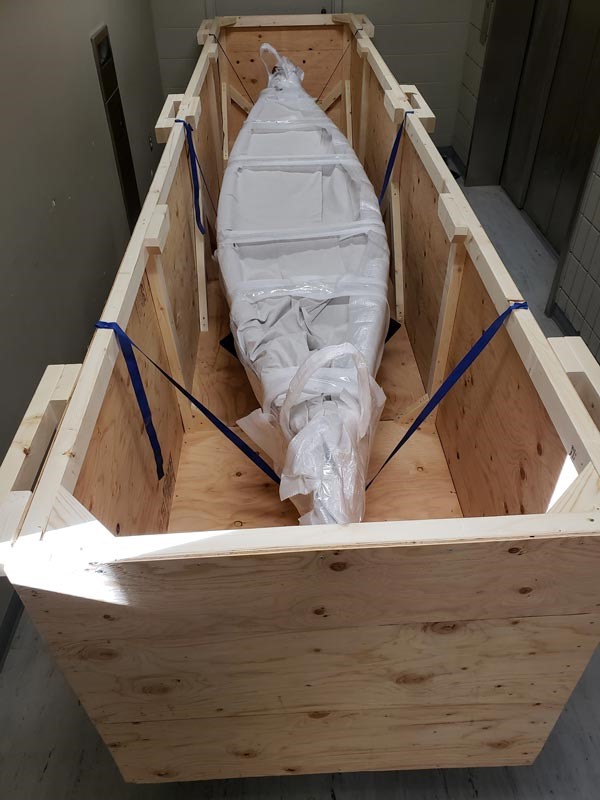
Waldram said “the canoe is an interesting case” because it was housed in the Archaeology Building for decades, but none of the department’s current faculty members or staff were involved in its acquisition nor knew its history.
“Nonetheless, it is extremely important to work with communities to repatriate items,” he said.
“Some communities prefer that some items remain with the institutions, while others set up cultural centres to house items. In some cases, items are extremely old and not linked to any current identifiable communities. Items can be acquired through a variety of means, including amateur collectors who pay less attention to origins. Repatriation often involves serious detective work.”
Waldram said the Department of Archaeology and Anthropology is focused on reconciliation and continues to “explore the possibilities for repatriation of both tangible and intangible cultural heritage.” In 2018, Waldram read a public statement on reconciliation that was created as the department marked its 50th anniversary.
“As a discipline, we were the first to work in (communities) and with Indigenous peoples to document aspects of their culture and history. Regrettably, in the past this was not always done with the respect that the TRC (Truth and Reconciliation Commission of Canada) notes is central to reconciliation, so we have an obligation to lead reconciliation efforts from our position as a university department and community of scholars,” he said. “We are fortunate that our entire faculty complement represents this new wave focused on meaningful research collaboration with Indigenous communities.”
Before the return of the canoe took place, Clark—who described the vessel as “a work of art”—was involved in featuring it during the Canadian Craft Federation’s Ten Digit Technology Conference held at Remai Modern in March 2020. Clark, a member of USask’s Shared Spaces project, which is supported through the Canada Council for the Arts’ Digital Strategy Fund, worked with others to use new technology to make a three-dimensional model of the canoe.
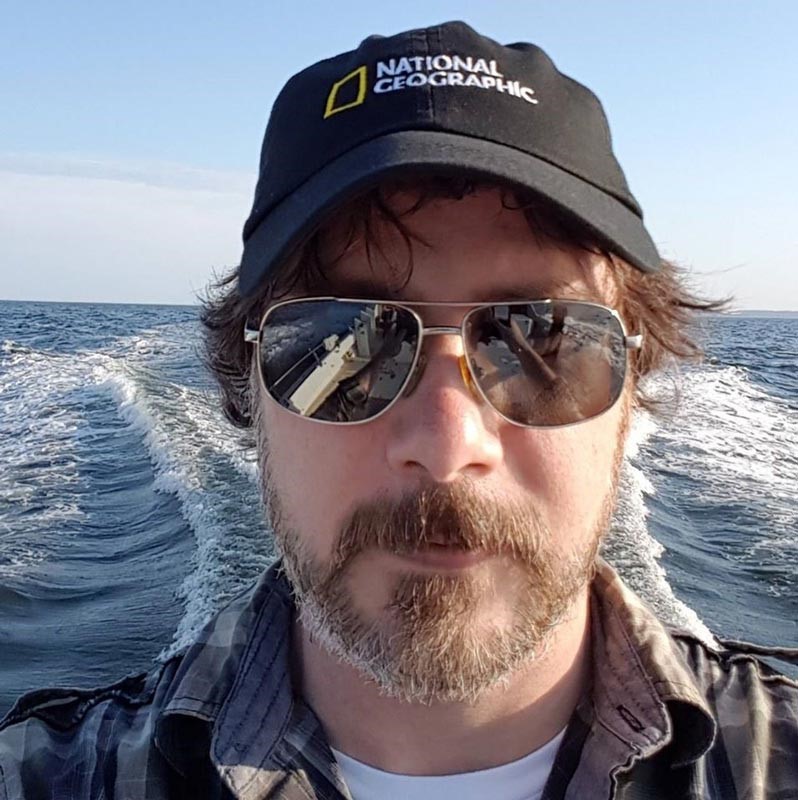
“We showed the actual canoe and then we projected, using augmented reality, a virtual canoe right beside it,” said Clark. “The detail was striking. You could walk around it; you could zoom right in on the detail. It was life-size, and then we were showing the (My Last Canoe) video at the same time. So I think we tried other ways to tell this amazing story (and let people know that) this canoe still exists, it was crafted by a master builder, and soon it was going to be going back to the community to keep telling its story.”
Gerald McKenzie, a councillor with the Lac La Ronge Indian Band, said the canoe arrived safely in Grandmother’s Bay on Oct. 21, and many community members came to see it. It is currently being stored in the Grandmother’s Bay school, and it will eventually be put on permanent display in a cultural centre named after Isaiah Roberts. McKenzie said it’s important that artifacts such as the canoe are returned to Indigenous communities.
“It’s to maintain our culture,” he said.
McKenzie wanted to acknowledge the efforts of other groups and individuals—including the Saskatchewan Archaeological Society, Tim Jones, USask Professor Emeritus Dr. David Meyer (PhD), Tom McKenzie and Doug Chisholm—who helped determine the whereabouts of the canoe and bring it home.
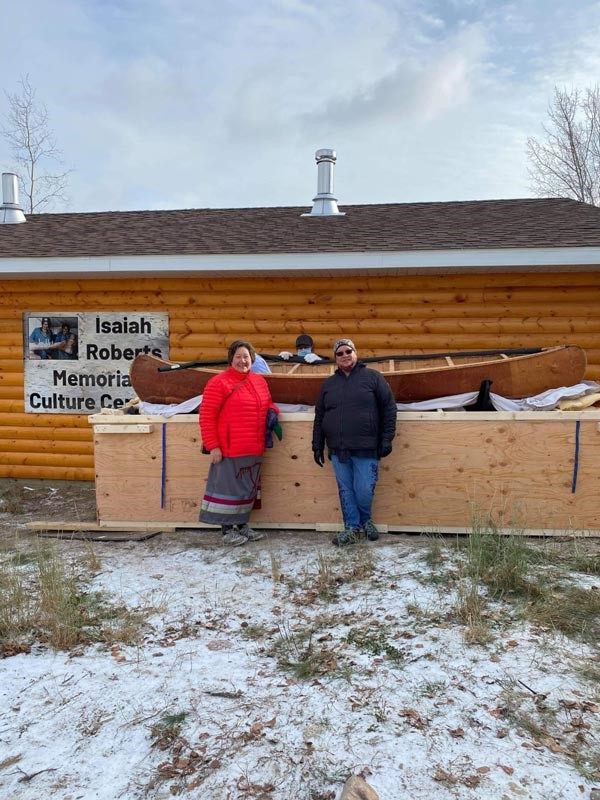
Before the canoe was shipped, Roberts said a prayer for its safe journey and put the four sacred medicines—tobacco, cedar, sage and sweetgrass—into the crate. A repatriation ceremony was later held on Oct. 23 in Grandmother’s Bay. The ceremony was small and was held outdoors due to COVID-19 precautions, said Roberts, who was one of the speakers. She described it as a “very heartwarming” event.
“It just felt like I had come full circle, to actually be there when they unwrapped the canoe and to be able to take the medicines out of the canoe and to burn them in a fire,” said Roberts.
“It’s back home.”

